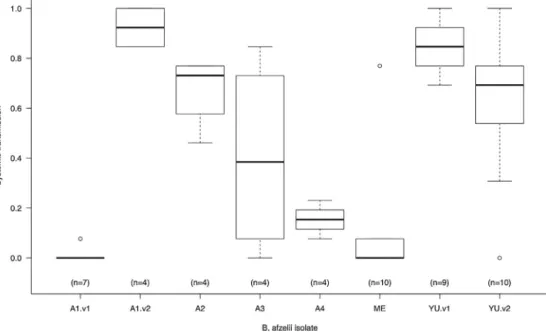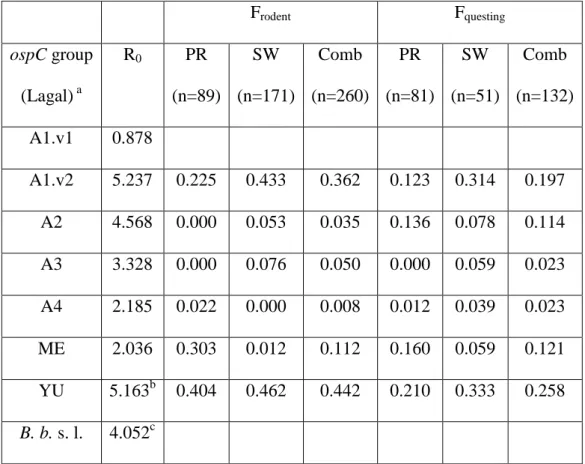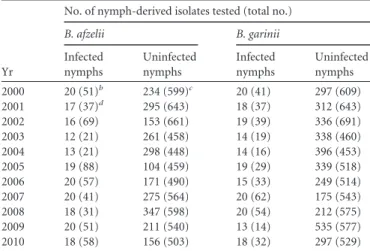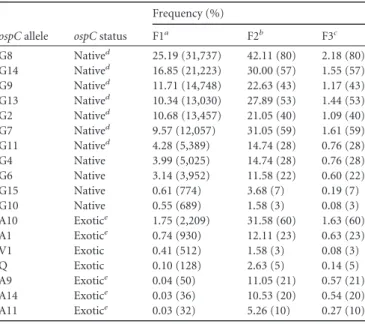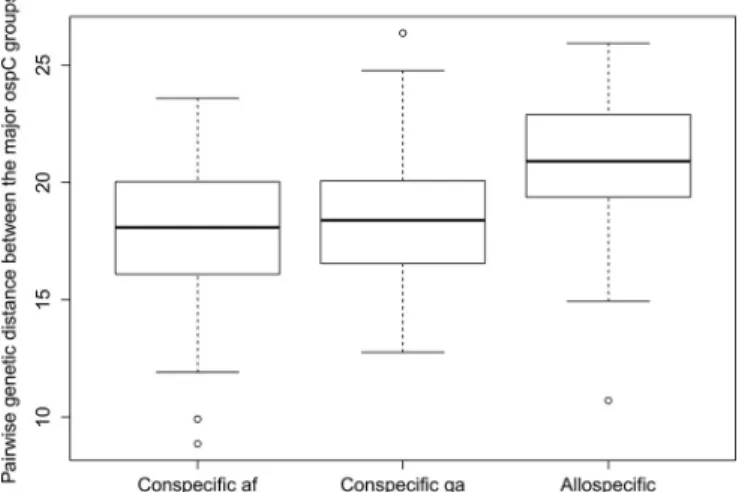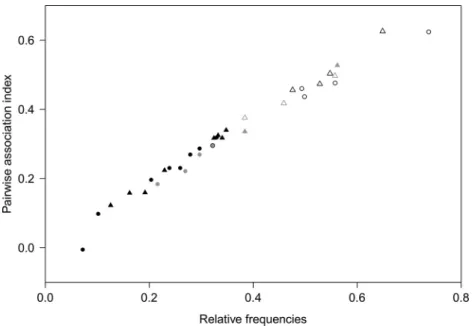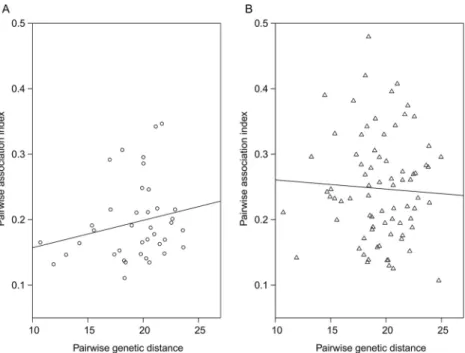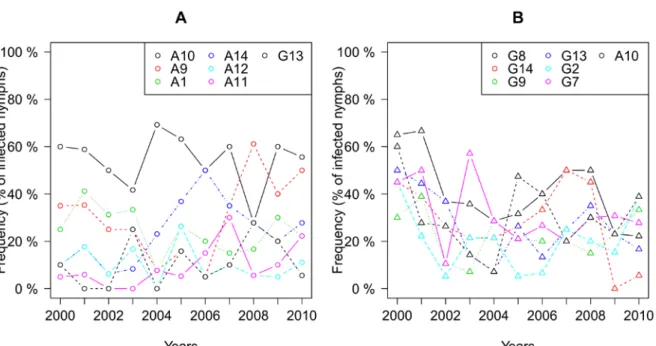1
University of Neuchâtel – Faculty of Sciences
Laboratory of Ecology and Evolution of Parasites
Evolution of a local population of a
multiple-strain pathogen in its vector
Thesis presented to the Faculty of Sciences of the University of Neuchâtel for the degree of Doctor of Sciences by
Jonas Durand
Defended on the 21st of April 2016 Accepted on proposition of the Jury:
Prof. Maarten Voordouw (thesis director, University of Neuchatel) Dr. Xavier Bailly (INRA Clermont-Ferrand)
Prof. Dustin Brisson (University of Pennsylvania) Prof. Lise Gern (University of Neuchatel)
Dr. Thomas Junier (University of Neuchatel) Prof. Jacob Koella (University of Neuchatel)
Secrétariat-décanat de Faculté Rue Emile-Argand 11 2000 Neuchâtel - Suisse Tél: + 41 (0)32 718 2100 E-mail: secretariat.sciences@unine.ch
Imprimatur pour thèse de doctorat www.unine.ch/sciences
IMPRIMATUR POUR THESE DE DOCTORAT
La Faculté des sciences de l'Université de Neuchâtel
autorise l'impression de la présente thèse soutenue par
Monsieur Jonas DURAND
Titre:
“Evolution of a local population of a
multiple-strain pathogen in its vector”
sur le rapport des membres du jury composé comme suit:
- Prof. ass. Maarten Voordouw, directeur de thèse, Université de Neuchâtel, Suisse
- Prof. ass. Lise Gern, Université de Neuchâtel, Suisse - Prof. Jacob Koella, Université de Neuchâtel, Suisse - Dr Thomas Junier, Université de Neuchâtel, Suisse
- Dr Xavier Bailly, INRA, Animal Health Dpt, Saint Genès Champarelle, France - Dr Dustin Brisson, University of Pennsylvania, Philadelphia, USA
5
Table of contents
Table of contents ... 5 1. Abstract ... 7 2. Résumé ... 11 3. General Introduction ... 15 3.1. Mixed infections ... 15 3.2. Borrelia species ... 17 3.2.1. Lyme borreliosis (LB) ... 183.2.2. Multiple infections in the ticks and the hosts ... 18
3.2.3. Effect of the infection on the reservoir hosts and the vector ... 19
3.2.4. Infection cycles of Borrelia spirochetes ... 20
3.2.5. Outer-surface protein C (OspC) ... 23
4. Aims of the PhD project ... 29
5. 1st paper ... 31
6. 2nd Paper ... 45
7. 3rd Paper ... 69
8. 4th Paper ... 117
9. Summary and general discussion ... 149
9.1. Maintenance of ospC diversity ... 149
9.2. Coinfection and competition ... 151
9.3. Presence of exotic ospC groups ... 152
9.4. Differences between Borrelia afzelii and Borrelia garinii. ... 156
10. Conclusion ... 159
11. References ... 161
12. Acknowledgements ... 183
7
1. Abstract
Mixed-strain infections are the rule rather than the exception in most infectious diseases, and have important implication for the ecology and evolution of pathogens. The presence of multiple strains results in competitive interactions that can have a strong impact on the population structure of the pathogen. In vector-borne diseases, most of the research on competition between pathogen strains has focused on the vertebrate host, and there is a lack of information about what happens inside the arthropod vector.
Lyme borreliosis is the most common vector-borne disease in the northern hemisphere. The causative agents are spirochete bacteria that belong to the group Borrelia burgdorferi sensu lato and that are transmitted among vertebrate host by hard ticks of the genus Ixodes. In Europe, the two most common species are Borrelia afzelii and Borrelia garinii, which are specialized on different classes of reservoir hosts: small mammals and birds, respectively. Each of these two Borrelia species can be further subdivided into genetically distinct strains. Mixed-strain infections are common in both the vertebrate host and the tick vector. Strains are often defined using the highly polymorphic ospC gene, which has a discrete pattern of genetic variation. A major ospC group is a cluster of ospC alleles that is more than 8% divergent in nucleotide sequence from other such clusters, whereas alleles within a major ospC group are less than 2% divergent from each other. The Borrelia species that have been studied to date contain about 20 different major ospC groups.
In the literature, there are currently two explanations for the maintenance of the ospC polymorphism: negative frequency-dependent selection (NFDS) or multiple host-as-niche polymorphism (MNP). NFDS states that rare alleles have a fitness advantage over common ones and should therefore invade the population. MNP states that the strains carrying the different major ospC groups are specialized on different host species, and that it is the host species richness that maintains the ospC diversity. We propose a third explanation that is
8
acquired immunity in the vertebrate host can drive the population structure of multiple-strain pathogens. This theory states that strong immune selection against immunodominant antigens will cause the pathogen strains to organize themselves into a set of unique serotypes that minimizes cross-reactive acquired immunity. These sets of antigenically distinct strains can remain stable over long periods of time and the frequency of each strain depends on its intrinsic fitness.
In a first study, we used 454-sequencing to characterize the ospC strain structure of B.
afzelii and B. garinii in a local population of questing Ixodes ricinus nymphs over a period of
11 years. We also used estimates of the intrinsic fitness of six strains of B. afzelii from a previous experimental infection study that used laboratory mice.
We did not find any intermediately divergent alleles in the population, which suggested that cross-immunity from the vertebrate host prevents invasion by intermediate strains. In both Borrelia species the community of strains was stable over 11 years. Our laboratory estimates of fitness explained 63% of the variation in the frequencies between the different strains. Our results were consistent with the theory of Gupta and colleagues that explains how strong cross-reactive acquired immunity can structure the community of a multiple strain pathogen, but not with the NFDS or MNP theories.
In the second study, we used 454 sequencing and qPCR estimates of the total spirochete load to estimate the ospC strain-specific spirochete load per tick. We analysed questing nymphs infected by either B. afzelii or B. garinii that had been captured over a period of 3 years in the same location as the previous study.
We found that ticks had a fixed carrying capacity for spirochetes resulting in strong competition between strains. In B. afzelii, strains with the highest spirochete load in the nymphal tick were the most common strains in the tick population. In B. garinii, strains
9
whose spirochete load was least affected by competition with other strains were the most common strains in the tick population. In both Borrelia species, the spirochete load in the tick is an important life history trait. Competition between Borrelia strains in the tick vector plays a critical role in the community structure of this multiple-strain, tick-borne pathogen.
In both studies, we found that nymphs infected with a single Borrelia species often carried ‘exotic’ major ospC groups that belonged to other Borrelia species. This result was surprising and reveals the importance of using de novo clustering methods to analyze high-throughput sequencing data. We propose two explanations for the presence of these exotic major ospC groups. One explanation is frequent horizontal transfer of the ospC groups between the different Borrelia species. The other explanation is that co-infections with B.
afzelii and B. garinii are an order of magnitude more common than previously suspected.
This work provides new insights on the evolution of multiple-strain Borrelia populations and on the importance of competitive interactions between pathogen strains in the arthropod vector.
Keywords: Borrelia afzelii, Borrelia garinii, ospC, Ixodes ricinus, Lyme borreliosis, mixed
11
2. Résumé
Dans la plupart des maladies infectieuses, les infections sont causées par différentes souches de la même espèce de pathogène. Ces infections multiples ont des implications importantes pour l'écologie et l'évolution de ces agents pathogènes. La présence de plusieurs souches au même endroit peut en effet conduire à des interactions compétitives qui peuvent avoir un impact fort sur la structure de la population de pathogènes. Dans les maladies à transmission vectorielle, la plupart des recherches sur les interactions entre les souches d’un pathogène se sont concentrées sur l'hôte vertébré, et il y a un manque d'information sur ce qui se passe à l'intérieur du vecteur.
La Borréliose de Lyme est la maladie vectorielle la plus courante dans l'hémisphère nord. Les agents pathogènes sont des bactéries spirochètes qui appartiennent au groupe
Borrelia burgdorferi sensu lato et sont transmis entre hôtes vertébrés par les tiques dures du
genre Ixodes. En Europe, les deux espèces les plus communes sont Borrelia afzelii et Borrelia
garinii, qui sont spécialisés sur différentes classes d'hôtes réservoirs: les petits mammifères et
les oiseaux. Chacune de ces deux espèces de Borrelia peut être subdivisées en différentes souches génétiquement distinctes. Les infections multiples causées par plusieurs souches sont communes à la fois chez l'hôte vertébré et chez la tique vectrice. Les souches sont souvent définies en utilisant le gène hautement polymorphe ospC, qui présente un motif de variation génétique particulier. En effet, un groupe majeur d’ospC est un groupe d'allèles d’ospC qui est plus de 8% différent dans sa séquence nucléotidique des autres groupes, alors que les allèles au sein d'un groupe majeur d’ospC sont moins de 2% différentes les unes des autres. Les espèces de Borrelia qui ont été étudiés à ce jour contiennent environ 20 différents groupes majeurs d’ospC.
Dans la littérature, il existe actuellement deux explications pour le maintien du polymorphisme sur le gène ospC : la sélection fréquence-dépendante négative (SFDN) ou le
12
meilleure valeur adaptative que les plus communes et devraient donc envahir la population. La PNM prédit que les souches portant les différents groupes majeurs d’ospC sont spécialisées sur différentes espèces d'hôtes, et que c’est la richesse en espèces d’hôtes qui maintient la diversité d’ospC. Nous proposons une troisième explication qui est basée sur des modèles théoriques publiés par Gupta et ses collègues, sur la façon dont une forte immunité acquise croisée chez l'hôte vertébré peut structurer une communauté de multiples souches de pathogène. Cette théorie prédit qu’une forte sélection immunitaire contre des antigènes immuno-dominants obligera les souches pathogènes à s'organiser en un ensemble de sérotypes uniques qui minimisent l'immunité acquise croisée. Ces ensembles de souches distinctes au niveau antigénique peuvent rester stables pendant de longues périodes de temps et la fréquence de chaque souche dépend de sa valeur adaptative intrinsèque.
Dans une première expérience, nous avons utilisé le séquençage 454 afin de caractériser les communautés de souches ospC de B. afzelii et B. garinii dans une population locale de nymphes Ixodes ricinus en quête, pendant une période de 11 ans. Nous avons également utilisé des estimations de la valeur adaptative intrinsèque de six souches de B.
afzelii provenant d'une étude précédente d'infection expérimentale de souris de laboratoire.
Nous n’avons pas trouvé d'allèles divergents intermédiairement (entre 2 et 8%) dans la population, ce qui suggère que l'immunité acquise croisée de l'hôte vertébré empêche l'invasion de la population par des souches intermédiaires. Chez les deux espèces de Borrelia la communauté des souches était stable pendant 11 ans. Nos estimations expérimentales de la valeur adaptative expliquent 63% de la variation dans les fréquences entre les différentes souches. Nos résultats étaient cohérents avec la théorie de Gupta et ses collègues qui explique comment une forte immunité acquise croisée peut structurer une communauté de multiples souches de pathogènes, mais pas avec les théories SFDN ou PNM.
13
Dans la deuxième expérience, nous avons utilisé le séquençage 454 et des estimations de la charge en spirochète totale pour estimer la charge en spirochète spécifique de chaque souche ospC dans chaque tique. Nous avons analysé les nymphes en quête infectées soit par
B. afzelii, soit par B. garinii, qui avaient été collectées pendant une période de 3 ans dans le
même endroit que l'étude précédente.
Nous avons constaté que les tiques ont une capacité de charge fixe entraînant une forte compétition entre les souches. Chez B. afzelii, les souches à la charge en spirochètes la plus élevée dans la tique étaient les souches les plus courantes dans la population de tiques. Chez B.
garinii, les souches dont la charge en spirochètes était la moins affectée par la compétition
avec d'autres souches étaient les souches les plus courantes dans la population de tiques. Chez les deux espèces de Borrelia, la charge en spirochètes dans la tique est un important trait d'histoire de vie. La compétition entre les souches de Borrelia dans la tique vectrice joue un rôle essentiel dans la structuration de la communauté de ce pathogène.
Dans les deux études, nous avons constaté que les nymphes infectées par une seule espèce de Borrelia contenaient souvent des groupes majeurs d’ospC « exotiques » qui appartenaient à d'autres espèces de Borrelia. Ce résultat est surprenant et révèle l'importance de l'utilisation de méthodes de classification de novo pour analyser les données de séquençage à haut débit. Nous proposons deux explications à la présence de ces groupes majeurs d’ospC exotiques. Il peut y avoir des transferts horizontaux fréquents d’allèles d’ospC entre les différentes espèces de Borrelia, ou les co-infections avec B. afzelii et B. garinii sont d’un ordre de grandeur plus fréquent qu'on ne le pensait.
Ce travail apporte un nouvel éclairage sur l'évolution des communautés de souches multiples de Borrelia et sur l'importance des interactions compétitives entre les souches pathogènes dans l’arthropode vecteur.
14
15
3. General Introduction
3.1. Mixed infections
Infections are frequently caused by multiple strains or genotypes of the same pathogen species (Read and Taylor 2001, Balmer and Tanner 2011). Mixed-strain infections create a complex challenge for the host immune system and can increase pathology and disease. In malaria for example, an increasing number of co-infecting strains is correlated with a higher disease risk (Zwetyenga et al. 1998, Basco and Ringwald 2007). From a public health perspective, mixed infections represent a major problem because they complicate the development of treatments and vaccines (Balmer and Tanner 2011, Johnson et al. 2015). Mixed infections are also of great interest to evolutionary biologists. For example theory suggests that they can select for more virulent pathogen genotypes (Van Valen 1973, Nowak and May 1994, May and Nowak 1995, de Roode et al. 2005, Schmid-Hempel 2011), but the contrary is also possible (Brown et al. 2002, Choisy and de Roode 2010, Staves and Knell 2010, Schmid-Hempel 2011). Pathogens that maintain a high density inside their host are more likely to be transmitted to the next host (or vector) and are less likely to be cleared by the host immune system. However, such virulent pathogens are also more likely to damage host tissues and reduce host fitness (Van Valen 1973, Nowak and May 1994, May and Nowak 1995, Schmid-Hempel 2011).
Mixed infections generally result in competitive interactions between pathogen strains (Read and Taylor 2001, Mideo 2009). These interactions are characterized as competition because the performance of a focal strain is reduced in the presence of other strains compared to its performance in single-strain infections. We can distinguish three different types of intraspecific competition: exploitation competition, interference competition, and apparent competition. In exploitation competition, pathogen strains compete with each other for limited
16
can produce strong competition between strains of Plasmodium (Mideo et al. 2008). Interference competition is the result of direct interactions between strains that can inhibit the growth, transmission or reproduction of their competitors. For example, strains of the pathogenic bacterium Haemophilus influenza produce highly specific toxins that are active against other strains but not against individuals from the same strain (Venezia and Robertson 1975). Apparent competition is mediated by the host immune system where a given strain induces a nonspecific or cross-reactive host immune response that has a negative impact on the other strains. This phenomenon has been demonstrated in the rodent malaria parasite
Plasmodium chabaudi (Råberg et al. 2006). However, for any demonstration of competition
between pathogen strains, it is often difficult to know which type of competition is at play (Mideo 2009).
In vector-borne diseases, mixed-strain infections are common and occur in both the vertebrate reservoir host and the arthropod vector (Schmid-Hempel 2011). Studies on competition between strains of vector-borne pathogens typically focus on the vertebrate reservoir host (Mercereau-Puijalon 1996, Smith et al. 1999, Read and Taylor 2001, De Roode et al. 2003, de Roode et al. 2005, Råberg et al. 2006, Mideo et al. 2008). To date, only a few studies have investigated mixed infections and inter-strain competition in the vector and its importance for the strain structure of the pathogen (Araújo et al. 2007, Peacock et al. 2007, Rego et al. 2014, Reif et al. 2014, Pollitt et al. 2015). All these studies suggest that interactions between pathogen strains in the arthropod vector can be dramatically different than the ones observed in the vertebrate host. For example, in the kissing bug Triatoma
brasiliensis, when two strains of Trypanosoma cruzi colonize the same individual vector they
occupy different parts of the insect gut (Araújo et al. 2007). Exploitation competition is avoided, and it is actually facilitation that is observed, with one strain more abundant in the
17
presence of the other. Another study on the tick-borne pathogen Francisella novicida found that intraspecific interactions within the tick vector Dermacentor andersoni can result in severe population bottlenecks and greatly influence the strain diversity in the pathogen population (Reif et al. 2014).
3.2. Borrelia species
Borrelia burgdorferi sensu lato (Adeolu and Gupta 2014), is a complex of bacteria
that contains different species of diderm spirochete bacteria, some of which cause Lyme borreliosis (LB) in humans. To date, up to 19 different species of Borrelia have been described in the world (Pritt et al. 2016). In Europe, the most common species are Borrelia
afzelii and Borrelia garinii (Rauter and Hartung 2005, Estrada-Peña et al. 2011). These two Borrelia species are both transmitted by the same generalist hard tick vector, Ixodes ricinus,
which feeds on a large range of vertebrate hosts. However, these Borrelia species are adapted to different vertebrate hosts: B. afzelii is specialized on small mammals (Humair and Gern 1998, Kurtenbach et al. 1998, Kurtenbach et al. 2002, Hanincova et al. 2003), whereas B.
garinii is specialized on birds (Kurtenbach et al. 1998, Kurtenbach et al. 2002, Hanincová et
al. 2003). This specificity is based on the fact that B. afzelii spirochetes are mostly found in small mammals, and that these small mammals are able to transmit the spirochetes to uninfected larval ticks (Humair et al. 1995, Humair and Gern 1998, Kurtenbach et al. 1998, Huegli et al. 2002, Kurtenbach et al. 2002, Hanincova et al. 2003). Conversely, B. garinii spirochetes are mostly found in birds, and these birds are able to transmit the spirochetes to uninfected larval ticks (Humair et al. 1998, Kurtenbach et al. 1998, Kurtenbach et al. 2002, Hanincová et al. 2003, Taragel'ová et al. 2008). This specificity is mediated by the complement system of the vertebrate host (Kurtenbach et al. 1998, Kurtenbach et al. 2002).
18
Lyme borreliosis (LB) is the most common vector-borne disease in Europe and North America. The first symptom is usually a rash at the site of the tick bite and is called an erythema migrans. If left untreated, LB patients can develop arthritis, joint pain, chronic fatigue, neurological problems, and skin disorders, depending on the species or strain of
Borrelia involved. The spirochetes are transmitted among vertebrate hosts by hard-bodied
ticks belonging to the genus Ixodes. Ixodes ticks have three obligate blood-feeding stages: larva, nymph, and adult. Lyme disease exists in nature because the two immature tick stages (larvae and nymphs) feed on the same set of susceptible vertebrate hosts (small mammals and birds). In contrast, the adult ticks are a dead-end for B. burgdorferi because they feed on larger hosts (e.g. deer) that are resistant to the spirochete (Telford 3rd et al. 1988, Jaenson and Tälleklint 1992, Matuschka et al. 1992, Ogden et al. 1997, Kurtenbach et al. 2006). Transovarial transmission of B. burgdorferi is believed to be rare in Ixodes ricinus (Bellet-Edimo et al. 2005, Richter et al. 2012, Rollend et al. 2013). However, a recent study has shown that B. afzelii-infected larvae, even if rare, are able to infect rodent hosts (van Duijvendijk et al. 2016). A more detailed description of the Lyme disease life cycle is as follows. In the early summer, infected nymphs transmit B. burgdorferi to susceptible hosts, which subsequently transmit the pathogen to the next generation of larval ticks in the late summer. These larval ticks molt into infected nymphs that overwinter and become active the following year when they infect the next generation of hosts and larval ticks. Humans are accidental hosts and are not part of the natural life cycle of Borrelia spirochetes.
3.2.2. Multiple infections in the ticks and the hosts
In Borrelia pathogens, multiple strain infections are common in both the tick vector and the vertebrate reservoir hosts. On average, 1.8 different strains are found in both questing
19
ticks (up to 11 different strains in one tick; Appendix Table 1), ticks feeding on the host (up to 7 strains in one tick; Appendix Table 2), and in the hosts (up to 6 different strains; Appendix Table 3). The observed strain richness is higher in studies that use next-generation sequencing (Durand et al. 2015, Strandh and Råberg 2015). A field study of B. afzelii strains in the wild rodent reservoir host found evidence of apparent competition (Andersson et al. 2013). This study found that B. afzelii strains that were genetically similar at the ospC locus (this gene codes for an immunodominant surface protein that induces a strong antibody response in the vertebrate host) were less likely to be found together in the same rodent reservoir host. A recent study on B. afzelii in wild reservoir hosts found evidence for competition because the strain-specific spirochete abundance was lower in mixed infections than in single infections (Strandh and Råberg 2015). In summary, Borrelia pathogens consist of multiple strains that compete with each other inside the vertebrate reservoir host.
3.2.3. Effect of the infection on the reservoir hosts and the vector
To date, almost no negative effect of Borrelia infection has been observed in reservoir hosts. An early experimental infection study of the white-footed mouse Peromyscus leucopus found that infant mice but not adult mice developed carditis and arthritis (Moody et al. 1994).
P. leucopus mice that had been experimentally infected with B. burgdorferi via tick bite
showed no changes in running behavior over a period of six weeks post-infection compared to uninfected control mice (Schwanz et al. 2011). Capture-mark-recapture (CMR) studies on populations of P. leucopus and Rissa tridactyla have found no evidence that infection with B.
burgdorferi reduces the survival of these wild reservoir hosts (Hofmeister et al. 1999,
Chambert et al. 2012, Voordouw et al. 2015).
In the tick vector, the effects of Borrelia infections are usually positive. Recent studies on B. afzelii-infected nymphs have shown that infected ticks have better survival under thermo-hygrometric stresses (Herrmann and Gern 2010), reduced horizontal movement along
20
2013), and better survival at cold temperatures (Herrmann and Gern 2013).
3.2.4. Infection cycles of Borrelia spirochetes
Host-to-larval tick transmission: The success of host-to-larval tick transmission
depends on the spirochete abundance in the host (Råberg 2012, Jacquet et al. 2015). Larvae start to acquire Borrelia spirochetes during the first 12 hours of attachment (Pal and Fikrig 2010). The spirochetes migrate from the host dermis to the tick where they attach to the midgut epithelium using Borrelia outer surface protein A (OspA). In the weeks following engorgement, the spirochetes multiply rapidly, but their abundance can drop five-fold during the larva-to-nymph molt (Piesman et al. 1990). Borrelia pathogens spend a long period of time (~8 months) in the midgut of the nymphal tick until the next blood meal (Tälleklint and Jaenson 1995, Lindsay et al. 1997). Spirochetes depend on the tick blood meal for nutrients (Dunham-Ems et al. 2009, Radolf et al. 2012). During the winter, the ticks produce glycerol as a putative natural antifreeze, which the spirochetes use as an energy source (Pappas et al. 2011). There is currently much scientific interest in identifying the genes that allow the spirochetes to persist inside the midgut of flat, unfed nymphs (Pappas et al. 2011, Kung et al. 2013, Fazzino et al. 2015). This part of the life cycle must be particularly challenging, as the bacteria suffer from nutritional stress and extreme changes in temperature. Spirochete persistence in the nymph midgut is probably a game of attrition, which the most abundant strains are more likely to win. Spirochete load inside the nymphal tick can decrease by as much as 90% over 8 months (Jacquet et al. 2015). A similar phenomenon was observed in I.
scapularis nymphs infected with B. burgdorferi (Voordouw et al. 2013). Both of these studies
involved laboratory populations of Ixodes ticks that were kept under laboratory conditions, but a decline in spirochete abundance has also been observed in wild adult ticks after winter (Sharon et al. 1992).
21
Nymph-to-host transmission: During the nymphal blood meal, only a few
spirochetes are able to complete the migration from the tick midgut to the salivary glands (Piesman 1993, Ohnishi et al. 2001, Piesman et al. 2001, Dunham-Ems et al. 2009). Borrelia spirochetes start to multiply rapidly in the tick midgut following tick attachment. At this stage, the spirochetes are still non-motile, but they penetrate more deeply into the midgut epithelium by dividing and forming networks that advance toward the basement membrane (Dunham-Ems et al. 2009). Only a few spirochetes manage to cross the midgut epithelium and enter the hemolymph (Coleman et al. 1997, Dunham-Ems et al. 2009). In the hemolymph, the spirochetes are motile but they are attacked by the hemocytes (immune cells) of the tick immune system (Johns et al. 2001, Hajdusek et al. 2013). The number of spirochetes that reaches the salivary glands is therefore very low (Spielman et al. 1987, Piesman 1993, Grimm et al. 2004, Fisher et al. 2005, Dunham-Ems et al. 2009). A qPCR study on B. burgdorferi in I.
scapularis suggested that less than 100 spirochetes reached the salivary glands of nymphal
ticks. These data are consistent with studies showing that only a small inoculum of spirochetes from the tick salivary glands is required to establish infection in a competent vertebrate host (Ohnishi et al. 2001, Lima et al. 2005). Spirochetes are usually detected in the tick salivary glands after 60 hours (Ohnishi et al. 2001, Dunham-Ems et al. 2009), but nymph-to-host transmission can start as early as 24 hours after attachment (Hodzic et al. 2002, Cook 2015). The large decline in spirochete abundance during the migration from the midgut to the salivary glands creates a population bottleneck that reduces the strain richness of the inoculum (Rego et al. 2014). Borrelia strains that start the journey with a higher abundance in the midgut are more likely to reach their final destination. A recent study used genetically tagged strains of B. burgdorferi (that were otherwise identical in fitness) to show that the more abundant strains in the nymphal tick had higher levels of nymph-to-host transmission (Rego et al. 2014).
22
inflammatory, and immune responses of the vertebrate host and thereby optimize blood uptake (Ribeiro et al. 1985, Brossard and Wikel 2004, Francischetti et al. 2009). Ticks create a zone of immunosuppression around the feeding lesion that is beneficial to both the tick and
Borrelia. Salivary gland extracts suppress both the innate and the acquired immune response
in the rodent host (Ribeiro 1987, Ribeiro et al. 1990, Mejri et al. 2002, Pechová et al. 2002, Guo et al. 2009). In addition, Borrelia spirochetes interact with the Salp15 protein from the tick saliva to evade antibody-mediated killing (Ramamoorthi et al. 2005). The spirochetes can remain at the inoculation site for several days before disseminating into the host (Shih et al. 1992). Borrelia pathogens have been recovered from numerous tissues and organs in the vertebrate host including the skin, blood, joints, spleen, heart, liver, urinary bladder, kidney, and nervous system (Gray et al. 2002).
Co-feeding transmission: Borrelia spirochetes can be transmitted from an infected
nymph to larvae via co-feeding transmission without necessarily establishing a systemic infection in the host (Gern and Rais 1996, Randolph et al. 1996, Voordouw 2015). Co-feeding transmission occurs when two ticks are feeding at the same time and in close proximity on the same host. This mode of transmission is particularly important in Europe where the peak questing activity of nymphs and larvae are synchronized (Kurtenbach et al. 2006). Co-feeding transmission may allow Borrelia pathogens to obtain some fitness benefits from vertebrate reservoir hosts that are otherwise refractory to systemic infection (Voordouw 2015). In the UK for example, Lyme disease was maintained via co-feeding transmission in a population of sheep, which is an incompetent host for spirochetes (Ogden et al. 1997). Other studies have shown that some species of Borrelia can be transmitted via co-feeding while feeding on incompetent hosts (Sato and Nakao 1997, Hu et al. 2003, Hasle 2013). A recent study on B.
co-23
feeding transmission success (Jacquet et al. 2015). This study also showed that the mode of transmission influenced the spirochete abundance in the nymphal tick. Nymphs that had acquired the spirochetes as larvae via co-feeding transmission had a spirochete load that was six times lower than nymphs that had acquired the infection as larvae via systemic transmission. As the spirochete abundance is important for nymph-to-host transmission, this result suggests that co-feeding nymphs are less infectious to vertebrate hosts than systemic nymphs.
The genome of Borrelia bacteria is very complex and consists of a linear chromosome (~910 kb) and a large number of circular and linear plasmids (~610 kb) (Fraser et al. 1997, Casjens et al. 2000, Casjens et al. 2012). The number of plasmids differs between Borrelia strains (Casjens et al. 2012). Plasmids can be horizontally transferred between strains (Livey et al. 1995, Wang et al. 1999, Qiu et al. 2004) and lost during in vitro growth (Barbour 1988, Schwan et al. 1988, Labandeira-Rey and Skare 2001). However, the gene repertoire remains surprisingly consistent between the different strains (Casjens et al. 2012). A Borrelia species is often considered as a complex of clones or strains, and strong linkage disequilibrium has been observed between different genes (Bunikis et al. 2004, Qiu et al. 2004, Hellgren et al. 2011, Brisson et al. 2012). The plasmids contain genes coding for various surface proteins that are expressed at different phases during the spirochete life cycle (Kenedy et al. 2012).
3.2.5. Outer-surface protein C (OspC)
OspC is a 22-kDa immunodominant protein (Fuchs et al. 1992, Marconi et al. 1993), and is highly polymorphic in a variety of Borrelia species. Some studies have suggested that OspC allows the spirochetes to migrate from the tick midgut to the tick salivary glands (Pal et al. 2004, Fingerle et al. 2007). However, the balance of evidence suggests that the OspC protein is essential for establishing infection in the vertebrate host (Grimm et al. 2004, Tilly et al. 2006). Two mechanisms have been described by which OspC infects the vertebrate host:
24
it to hide from the host immune system and (2) OspC binds to host plasminogen, which allows it to cut through host tissue and reach the circulatory system (Lagal et al. 2006, Onder et al. 2012). The OspC protein is expressed during the early stages of the infection and induces a strong antibody response in the infected host (Schwan et al. 1995, Schwan and Piesman 2000, Ohnishi et al. 2001, Liang et al. 2002, Liang et al. 2004). This pathogen protein is therefore under strong selection pressure by the vertebrate immune system (Theisen et al. 1993, Fung et al. 1994). The ospC gene is encoded on the circular plasmid Cp26 (Sadziene et al. 1993) and has a large amount of sequence variation that can be classified into discrete major ospC groups within each Borrelia species. A major ospC group is defined as a group of ospC alleles that are >8% (average difference of ≈20%) divergent in their DNA sequence from other such groups and <2% divergent (average difference of ≈1%) within the same major group (Wang et al. 1999). These major ospC groups can be considered as different strains, especially in local populations in which linkage disequilibrium is very high (Hellgren et al. 2011). Experimental infections of rodents with genetically defined strains of
Borrelia have found substantial variation in fitness between strains (Derdáková et al. 2004,
Hanincová et al. 2008, Tonetti et al. 2015).
The ospC gene exhibits a discrete pattern of genetic variation and sequences that are intermediately divergent (2–8%) have not been found (Baranton et al. 2001). This pattern of divergence suggests two conflicting selection pressures. On the one hand, a given OspC protein is under strong divergent selection to escape into an immune-free space where it cannot be recognized by the antibodies developed against other OspC variants. On the other hand, the OspC protein is also under stabilizing selection to maintain its ability to establish infection in the vertebrate host. The diversity of major ospC groups suggests that there are many ospC variants that are functional but the lack of divergence within a major ospC group
25
suggest that there are functional constraints. Alternatively, cross-reactive antibodies developed against the common major ospC groups prevent the mutant intermediately divergent ospC alleles from increasing to a detectable frequency. The ospC gene can be subdivided into regions that are more or less conserved (Livey et al. 1995, Theisen et al. 1995, Wang et al. 1999). These regions present different rates of recombination (Livey et al. 1995) and different ratios of synonymous (ds) to non-synonymous substitutions (dn) (Theisen et al. 1995, Wang et al. 1999), suggesting that they do not evolve at the same speed, and are not under the same selection pressure.
There is much interest in determining the factors that maintain the ospC polymorphism in Borrelia species. Two alternative but non-exclusive explanations are negative frequency-dependent selection (NFDS) (Qiu et al. 1997, Wang et al. 1999) and multiple-niche polymorphism (MNP) (Brisson and Dykhuizen 2004). Strong selection pressure from the vertebrate immune response (Gilmore et al. 1996) could be sufficient to create NFDS. This theory is supported by the high rates of recombination and the low ds/dn ratio in this gene (Theisen et al. 1995, Wang et al. 1999, Haven et al. 2011). According to the Lyme disease literature, NFDS should lead to fluctuations in the frequencies of the major
ospC groups (Kurtenbach et al. 2006, Tsao 2009, Brisson et al. 2012). However, it is
important to point out that NFDS can also produce stable polymorphisms where there are no cycles in genotype frequencies (Ayala and Campbell 1974). To date, only Wang et al. (1999) have proposed an immunological mechanism that could actually drive NFDS of the ospC gene. Wang et al. (1999) stated that, “anti-OspC antibodies can prevent reinfection with the same strain and clear present infections” and that, “The most abundant ospC population will, on average, be the group that a host responds to immunologically both first and most strongly. Thus a rare type is more likely to establish a persistent infection than a common one and be passed onto the next generation of ticks.” The idea that frequent exposure to the same OspC
26
number of reasons. First, the general consensus is that Boreliella pathogens establish chronic, life-long infections in their rodent reservoir hosts (Donahue et al. 1987, Gern et al. 1994, Richter et al. 2004). Second, expression of the OspC antigen is down regulated once the
Boreliella pathogen has established a disseminated infection in the vertebrate host (Schwan et
al. 1995, Schwan and Piesman 2000, Ohnishi et al. 2001, Liang et al. 2002, Liang et al. 2004), and OspC-specific antibodies therefore cannot clear chronic infections. Third, a recent study in our group found that there was no difference in spirochete transmission to larval ticks between mice that were exposed once or twice to the same ospC strain via tick bite (unpublished data). This experiment suggests that repeated exposure to the same strain does not have a negative effect on host-to-tick transmission.
Brisson and Dykhuizen (2004) proposed the MNP explanation for B. burgdorferi in the eastern United States after showing that the major ospC groups were associated with certain host species. For example, major ospC group B was found in the white-footed mouse,
Peromyscus leucopus, but not in the other three host species. In contrast, major ospC group I
was found in P. leucopus and the eastern chipmunk, Tamias striatus, but not in the other host species. They concluded that some B. burgdorferi ospC strains were unable to infect certain vertebrate host species. The strongest evidence for the MNP hypothesis in the United States is the fact that there are some major ospC groups that have been found in ticks but that have never been isolated from the common vertebrate reservoir hosts. This observation suggests that these ospC strains are circulating in other vertebrate reservoir host species.
Divergent selection by the acquired immune system of the vertebrate host has driven the diversification and adaptive radiation of the ospC gene (Theisen et al. 1993). Immunization studies with recombinant OspC proteins have shown that OspC-specific antibodies provide strain-specific protection against super-infection with strains carrying the
27
same but not different major ospC group alleles (Probert et al. 1997, Earnhart et al. 2005, Jacquet et al. 2015). Thus any immunological theory for the ospC polymorphism must consider the role of the adaptive arm of the vertebrate immune system. In the late 1990s, Gupta and colleagues developed a body of theoretical work that explained how cross-reactive acquired immunity in the vertebrate host could structure pathogen populations into discrete strains. This theory showed that strong immune selection against immunodominant antigens can cause the pathogen population to organize into antigenically distinct strains or serotypes that induce strain-specific immunity (Gupta et al. 1996, Gupta and Anderson 1999). These sets of antigenically distinct strains can remain stable over long periods of time and the frequency of each strain depends on its intrinsic fitness (Gupta et al. 1998, Gupta and Anderson 1999). Such systems are difficult to invade by mutant pathogen strains because the host population has been saturated with antigenic variants so that there is no immune-free space left for the mutant to occupy (Gupta et al. 1996). When the host immune response is not strong enough to induce a stable community of antigenically distinct strains, the frequencies of the strains can exhibit cyclical or chaotic fluctuations (Gupta et al. 1998, Gupta and Anderson 1999). Thus studies that monitor the frequencies of pathogen strains over time can provide insight into how acquired immunity in the host population shapes the epidemiology of multiple-strain pathogens (Plummer et al. 1989, Brunham et al. 1996, Bambini et al. 2013).
29
4. Aims of the PhD project
The purpose of the present work was to investigate how the ospC strain diversity of
Borrelia pathogens could be maintained in a local population of I. ricinus ticks. We decided
to study the two most common Borrelia species in Europe: B. afzelii and B. garinii.
In the first paper, we studied the influence of genetic variation in the transmission success of B. afzelii spirochetes. We measured the transmission rate of nymph-to-host, host-to-larvae, and cofeeding transmission for six strains of B. afzelii. We used next generation matrix models to combine these transmission components into a single estimate of the reproductive number (R0) for each B. afzelii strain. We also tested whether these
strain-specific estimates of R0 were correlated with the strain-specific frequencies in the field
obtained from a previous study (Pérez et al. 2011).
In the second paper, we characterized the community of major ospC group alleles for
B. afzelii and B. garinii in a local population of I. ricinus ticks. Pérez et al (2011) had
previously used cold single-strand conformation polymorphism (SSCP) to characterize the
ospC strain diversity of B. afzelii in I. ricinus ticks and in wild rodent reservoir hosts at two
different sites in Switzerland over three years. In contrast, we wanted to examine whether the community of ospC strains changed over time in a local population of I. ricinus ticks. In addition, we wanted to use next generation sequencing to characterize the ospC strain diversity to a much higher resolution. This approach produced a large number of ospC gene sequences (240,000 reads) and allowed us to screen for intermediately divergent major ospC groups (divergence of 2–8% in the DNA sequence). In addition, we wanted to test whether there was a positive relationship between the pairwise genetic distance between the major
ospC groups and their degree of association in the I. ricinus nymphs, as had been previously
30
I. ricinus ticks over a period of 11 years. Specifically, we wanted to test whether the
frequencies of the major ospC groups would fluctuate over the duration of our study. We also tested the theory by Gupta and colleagues that states that strong cross-reactive acquired immunity in the vertebrate host can cause the pathogen population to diverge into a set of non-overlapping serotypes that can remain stable over long periods of time (Gupta et al. 1996, Gupta and Anderson 1999). In this scenario, the pathogen is a complex of independent strains and the frequency of each strain should depend on its intrinsic fitness (Gupta et al. 1998, Gupta and Anderson 1999). We used laboratory estimates of fitness of six different strains of
B. afzelii from the first paper to test the prediction that the frequency of each strain should
depend on its intrinsic fitness (Tonetti et al. 2015).
In the fourth paper, we studied competition between ospC strains in the tick vector separately for each of the two Borrelia genospecies: B. afzelii and B. garinii. We used 454-sequencing to characterize the ospC strain diversity of I. ricinus nymphs infected with either
B. afzelii or B. garinii. These nymphs had been sampled over a period of 3 years from the
same site as the previous 11-year study. The spirochete abundance of each nymphal tick had been determined using qPCR in previous studies (Herrmann and Gern 2010, Herrmann and Gern 2012, Herrmann and Gern 2013, Herrmann et al. 2013). We combined the spirochete load data and the ospC strain community data to test whether there was competition between strains in the tick vector.
31
5. 1
st
paper
Genetic variation in transmission success of the Lyme borreliosis pathogen Borrelia
afzelii
Nicolas Tonettia, Maarten J. Voordouwb, Jonas Durandb, Séverine Monniera, Lise Gerna
a
Laboratory of Eco-Epidemiology of Parasites, Institute of Biology, University of Neuchâtel, Neuchâtel, Switzerland
b
Laboratory of Ecology and Evolution of Parasites, Institute of Biology, University of Neuchâtel, Neuchâtel, Switzerland
ContentslistsavailableatScienceDirect
Ticks
and
Tick-borne
Diseases
jo u r n al h om ep ag e :w w w . e l s e v i e r . c o m / l o c a t e / t t b d i s
Originalarticle
Genetic
variation
in
transmission
success
of
the
Lyme
borreliosis
pathogen
Borrelia
afzelii
NicolasTonettia,1,MaartenJ.Voordouwb,∗,1,JonasDurandb,SéverineMonniera,
LiseGerna
aInstituteofBiology,LaboratoryofEco-EpidemiologyofParasites,UniversityofNeuchâtel,Neuchâtel,Switzerland bInstituteofBiology,LaboratoryofEcologyandEvolutionofParasites,UniversityofNeuchâtel,Neuchâtel,Switzerland
a r t i c l e i n f o Articlehistory:
Received24September2014 Receivedinrevisedform 27December2014 Accepted16February2015 Availableonline4March2015 Keywords: Borreliaafzelii Co-feedingtransmission Ixodesricinus Lymeborreliosis Reproductivenumber Vector-bornepathogen a b s t r a c t
Thevector-to-hostandhost-to-vectortransmissionstepsarethetwocriticaleventsthatdefinethelife cycleofanyvector-bornepathogen.Weexpectnegativegeneticcorrelationsbetweenthesetwo trans-missionphenotypes,ifparasitegenotypesspecializedatinvadingthevectorarelesseffectiveatinfecting thevertebratehostandviceversa.Weusedthetick-bornebacteriumBorreliaafzelii,acausativeagent ofLymeborreliosisinEurope,totestwhethergenetictrade-offsexistbetweentick-to-host,systemic (host-to-tick),andathirdmodeofco-feeding(tick-to-tick)transmission.Weworkedwithsixstrainsof B.afzeliithatweredifferentiatedaccordingtotheirospCgene.Wecomparedthethreecomponentsof transmissionamongtheB.afzeliistrainsusinglaboratoryrodentsasthevertebratehostandalaboratory colonyofIxodesricinusasthetickvector.Weusednextgenerationmatrixmodelstocombinethese transmissioncomponentsintoasingleestimateofthereproductivenumber(R0)foreachB.afzeliistrain.
Wealsotestedwhetherthesestrain-specificestimatesofR0werecorrelatedwiththestrain-specific
frequenciesinthefield.Wefoundsignificantgeneticvariationinthethreetransmissioncomponents amongtheB.afzeliistrains.Thisisthefirststudytodocumentgeneticvariationinco-feeding transmis-sionforanytick-bornepathogen.Wefoundnoevidenceoftrade-offsasthethreepairwisecorrelations ofthetransmissionrateswereallpositive.TheR0valuesfromourlaboratorystudyexplained45%ofthe
variationinthefrequenciesoftheB.afzeliiospCstrainsinthefield.Ourstudysuggeststhatlaboratory estimatesofpathogenfitnesscanpredictthedistributionofpathogenstrainsinnature.
©2015ElsevierGmbH.Allrightsreserved.
Introduction
Theabilitytoestablishaninfectioninanaivehostand transmis-siontosecondaryhostsarethecriticalfitnesscomponentsofthe parasitelifecycle.Parasitepopulationsoftenexhibitgenetic vari-ationinlifehistorytraitsdespitethefactthatthesecharactersare expectedtobeunderstrongselection.Lifehistorytheorysuggests thatnegativegeneticcorrelations(trade-offs)betweendifferent componentsoftheparasitelifecyclecaninfluencetheevolution oftheoptimalparasitephenotype(Stearns,1992).Previouswork hasshowntrade-offsamongavarietyofparasitelifehistorytraits
∗ Correspondingauthorat:InstituteofBiology,UniversityofNeuchâtel,Rue Emile-Argand11,CH-2000Neuchâtel,Switzerland.Tel.:+41327183114; fax:+41327183001.
E-mailaddresses:nicolas.tonetti@icloud.com(N.Tonetti),
maarten.voordouw@unine.ch(M.J.Voordouw),jonas.durand@unine.ch(J.Durand), severine.monnier@unine.ch(S.Monnier),lise.gern@unine.ch(L.Gern).
1 Thesetwoauthorscontributedequallytothiswork.
includingwithin-and among-hosttransmission,abilitytoavoid clearancebythehostimmunesystem,andparasitelifeexpectancy (deRoodeetal.,2008;Ebert,1998;Fraseretal.,2007;Mackinnon etal.,2008;MackinnonandRead,1999).Thesetrade-offsareof considerableinterestbecausetheydrivetheevolutionofvirulence, whichisthelevelofparasite-inducedharmtothehost(Ebertand Bull,2003).
Lifehistorytrade-offsmightbeparticularlyprevalentin vector-borne pathogens that areadapted to livein two verydifferent environments: an arthropodvector and a vertebrate host. The life cycle of all vector-borne pathogens contains two critical transmission events: vector-to-host transmission and host-to-vectortransmission(Randolph,1998).Vector-to-hosttransmission requiresthepathogentocolonizethetransmissiontissuesofthe vector (often the salivary glands) and avoid clearance by the vertebrateimmunesystem.Host-to-vectortransmissionrequires ingestion of the pathogen by the vector from the host tissues (blood,skin)andresistanceagainstthearthropodimmunesystem. Thegeneticandphysiologicalmechanismsunderlyingthesetwo
http://dx.doi.org/10.1016/j.ttbdis.2015.02.007 1877-959X/©2015ElsevierGmbH.Allrightsreserved.
transmissioneventsarelikelytobeverydifferent(Tsao,2009).For example,pathogeninteractions withvector salivainfluencethe efficacyof vector-to-hosttransmission(TitusandRibeiro,1988; Wikel,1999)whereaspathogenloadinthevertebratehost deter-mineshost-to-vectortransmissionsuccess(deRoodeetal.,2005; Raberg, 2012). Given the difficulty of adapting to both vector andhost,weexpectvector-bornepathogenstoexhibittrade-offs betweenvector-to-hostandhost-to-vectortransmissionsuccess. Inthepresentstudy,wetestthishypothesisusingthetick-borne pathogen,Borreliaafzelii.
Thetick-bornespirochetebacterium,B.afzelii,isoneofthemost importantcausesofLymeborreliosisinEurope(PiesmanandGern, 2004).Thispathogenusesthetick,Ixodesricinus,asitsvectorand avarietyofrodentspeciesasitsreservoirhosts(HumairandGern, 1998;Humairetal.,1995;Kurtenbachetal.,1998).B.afzelii estab-lishesachronicandsystemicinfectioninsiderodenthosts.Studies onB.afzeliihavefoundthathost-to-ticktransmissionrateswere highoverthelifetimeoftheinfection(Gernetal.,1994;Humair etal.,1999).Incontrast,studiesonB.burgdorferisensustricto(s. s.)havefoundthathost-to-ticktransmissioncandeclinerapidly overshorttimeperiods(i.e.onemonth)(Derdakovaetal.,2004; Hanincovaet al.,2008;Lindsay etal., 1997).In additiontothe classicmodeofsystemictransmission,B.afzeliiisalsocapableof co-feedingtransmission(GernandRais,1996;Huetal.,2003;Richter etal.,2002).Co-feedingtransmissionoccurswhenthepathogenis transmitteddirectlybetweenvectorsthatarefeedingonthesame hostatthesametimeandcanoccurintheabsenceofsystemic infection(Randolphetal.,1996;Voordouw,2015).Arecentfield studysuggestedthatstrainsofB.afzeliimaydifferintheirefficacy ofco-feedingtransmission(Pérezetal.,2011).Thesefindings moti-vatedustotestwhethertheefficacyofco-feedingtransmission differedamongstrainsofB.afzeliiinthepresentstudy.
LocalpopulationsofBorreliapathogensoftencontainanumber ofgeneticallydiversestrains(Pérezetal.,2011;Qiuetal.,2002). Previousgeneticworkhasshownthatthereisverylittlehorizontal genetransferandthatBorreliastrainsareessentiallyclonal(Bunikis etal.,2004;DykhuizenandBaranton,2001;Hellgrenetal.,2011; Qiuet al., 2004).The ospCgene, which codes for outersurface proteinC(OspC),isacommonlyusedgeneticmarkerto differen-tiateamongstrains(Wangetal.,1999).Strainsdifferingattheir ospC genotype have been compared with respect toa number ofdifferentphenotypesexpressedinthevertebratehost includ-ingspirocheteload,pathology,antibodyprofiles,andhost-to-tick transmission(Baumetal.,2012;Derdakovaetal.,2004;Hanincova etal.,2008;Wanget al.,2001,2002).Inthepresent study,the ospCgeneisofparticularinterestbecausetheOspCproteinplays acriticalroleduringthetick-to-hosttransmissionevent(Radolf andCaimano,2008;Tillyetal.,2008).Mutantstrainslackingthe ospCgeneareunabletocolonizetheticksalivaryglands(Fingerle etal.,2007;Paletal.,2004)and/orthevertebratehost(Grimm etal.,2004;Tillyetal.,2006).Thusinthepresentstudy,theospC geneisbothapotentialvirulencefactorandastrain-specificgenetic marker.
Thepurposeofthisstudywastotestwhethertherewasgenetic variationandcovariation amongstrainsofB.afzeliiinthethree canonical fitnesscomponentsof anytick-bornepathogen: tick-to-host transmission, host-to-tick (systemic) transmission, and tick-to-tick(co-feeding)transmission.AsB.afzeliiisaspeciesthat isspecializedonrodents(PiesmanandGern,2004),weused labo-ratorymiceasanapproximatemodelofthewildrodentreservoir host.OurlaboratorycolonyofI.ricinuswasusedasthetickvector. ForeachB.afzeliistrain,wecombinedthetransmission compo-nentsintoasingleestimateofthereproductivenumber(R0)using
recentlydevelopednextgenerationmatrixmodels(Harrisonand Bennett,2012;Harrisonetal.,2011;Harteminketal.,2008).R0
measurestheabilityofapathogentoinvadeandpersistinthehost
populationandprovidesaconvenientframeworkforcomparing fitness between pathogen strains. Theory predicts that in the absenceofinter-straincompetition,eachstrainwillrisetoa fre-quencythatiscommensuratewithitsR0value(Guptaetal.,1998).
RecentworkbyourgroupestimatedthefrequenciesofB.afzelii strains(usingtheospCgeneasamarker)inwildI.ricinusticksat twositesinSwitzerland(Pérezetal.,2011).Inthepresentstudy, wetestedwhetherourstrain-specificestimatesofR0inlaboratory
micewerepredictiveofthefrequenciesoftheB.afzeliistrainsin thefield.
Materialsandmethods Miceandticks
Pathogen-free,onemonth-old,maleBALB/cmicewereusedin thisstudyandwerehousedinseparatecages.Priortoany inva-siveprocedures(inoculationofspirochetes,tickinfestations,and ear biopsies), micewere anaesthetized with a mix of xylazine (Xylasol®,10mg/kg)andketamine(Narketan®,100mg/kg)to
min-imizediscomfort.Tickinfestationsandearbiopsieswereattempted onlyafterthelossoftoepinchreflexes.Larvalandnymphalticks camefromthelaboratorycolonyofspirochete-freeI.ricinusticks oftheUniversityofNeuchâtelandwererearedaccordingtoGraf (1978).Infectednymphaltickswereusedonemonthafter moult-ingandxenodiagnosticlarvaltickswereusedatleastonemonth afterhatching.AllexperimentsinvolvingmicerespectedtheSwiss legislationonanimalexperimentationandwereauthorizedbythe VeterinaryServiceoftheCantonofNeuchâtel(Authorization num-bers1/2006and2/2009).
Borreliaafzeliiisolates
MostoftheB.afzeliiisolatesusedinthisstudycamefromthe isolatecollectionoftheUniversityofNeuchâtel(Table1).These isolateswereobtainedfromticksandrodentearbiopsiesthathad beencollectedattwodifferentsitesinSwitzerland: Glütschbach-tal(Thoune,Bern,Switzerland)andBoisdel’Hôpital(Neuchâtel, Switzerland).Allisolateshadbeenpassagedfewerthanfivetimes toavoidthelossofthevirulencegenesthatarecriticalforinfection. However,itispossiblethatourlow-passagetreatmentreducedthe infectiousnessoftheculturedisolates(Ebert,1998).StrainsE61and P/stowereobtainedfromthePasteurInstitute,Parisbecauseour SwisscollectionofB.afzeliiisolatesdidnotcontainospCgroupsA3 andA4(Table1).
TheB.afzeliiisolateswereselectedtorepresentadiversityof ospCgroups.ThenomenclatureoftheB.afzeliiospCgroupsusedin thepresentstudywasdevelopedbyLagaletal.(2003)andwasalso usedinthestudybyPérezetal.(2011).WenotethatBunikisetal. (2004)developedadifferentnomenclaturefortheB.afzeliiospC groupsthatisalsousedintheliterature(Table1).AllospCgroups usedinthepresentstudyareknowntoinfectwildrodents(Pérez etal.,2011).TheisolateswithospCgroupYUwereofparticular interestbecausetheyappeartohavehighco-feedingtransmission (Pérezetal.,2011).Weusedexperimentalinfectionvianeedle inoc-ulation(seebelow)todeterminewhichisolateswereinfectious forBALB/cmiceandretainedeightisolatesbelongingtosixospC groups:NE4053(A1.v1),NE5046(A1.v2),NE36(A2),E61(A3),P/sto (A4),NE4054(ME),NE4049(YU.v1),andNE4051(YU.v2)(Table1). IsolatesNE4053and NE5046bothhadospCgroupA1and were thereforedesignatedA1variant1(A1.v1)andA1variant2(A1.v2). Similarly,isolatesNE4049andNE4051bothhadospCgroupYUand werethereforedesignatedYUvariant1(YU.v1)andYUvariant2 (YU.v2).TheospCgroupofeachisolatewasdeterminedviaDNA sequencing(seebelow).
Table1
TheeightBorreliaafzeliiisolatesusedinthisstudyareshown.TheisolatesaredifferentiatedaccordingtotheirospCgenegroupforwhichtherearetwodifferentnomenclatures. Foreachisolate,thecountryandsiteoforigin,thesourceoftheisolate,andtheGenbankaccessionnumberoftheospCgenesequenceareshown.
Isolate ospCLagala ospCBunikisb Country Site Source Genbank#
NE4053 A1.v1 A9.v1 Switzerland Neuchâtel Tick JX103490
NE5046 A1.v2 A9.v2 Switzerland Neuchâtel Tick JX103493
NE36 A2 A1 Switzerland Thune Mouse KC207939
E61c A3 A3 Austria Human L42890
P/stoc A4 A12 Germany Human AY150205
NE4054 ME A2 Switzerland Neuchâtel Tick JX103491
NE4049 YU.v1 A10.v1 Switzerland Neuchâtel Tick JX103488
NE4051 YU.v2 A10.v2 Switzerland Neuchâtel Tick JX103489
aNomenclatureofB.afzeliiospCgroupsdevelopedbyLagaletal.(2003)andbyPérezetal.(2011).Thisterminologyisusedinthepresentstudy. b NomenclatureofB.afzeliiospCgroupsdevelopedbyBunikisetal.(2004).
c ObtainedfromG.Baranton,InstitutePasteur,Paris.
Obtainingexperimentallyinfectednymphalticks
Experimentallyinfectednymphaltickswereusedtomeasure tick-to-host transmissionand were createdas follows. Each of theeightB.afzeliiisolateswasculturedin5mltubescontaining BSK-H medium(Sinskyand Piesman, 1989)at 34◦C and
spiro-chetedensitieswereestimatedusingaHelbercountingchamber. ForeachoftheeightB.afzeliiisolates,atleasttwonaïveBALB/C mice were inoculated subcutaneously in the neck with 200!l ofBSK mediumcontaining 2.0×106spirochetes/ml. Thirtydays post-inoculation,micewereinfested withapproximately100I. ricinuslarvae.Infestedmicewereplacedinspecialcagesto facili-tatethecollectionofblood-engorgedlarvae.Blood-engorgedlarvae wereplacedincollectingtubesandwereallowedtomoulttothe nymphalstage (Graf, 1978).One month aftermoulting, a hap-hazardlyselectedsubsetof‘sentinel’nymphs(n=13/mouse)was screenedtodeterminetheproportionofinfected ticksforeach isolate.Fortheeightisolates,theproportionofinfectednymphs rangedfrom0.154(2/13)to1.000(13/13).Theremainingnymphal ticksthathadnot beenusedforscreening andthat hadfedon the same mice as the sentinel nymphs will be referred to as the‘challenge’nymphs. Thesechallengenymphs,for whichthe strain-specificprobabilityofinfectionhadbeenestimatedfromthe sentinelnymphs,wereusedtochallengethemiceandmeasurethe strain-specifictick-to-hosttransmissionrates(seebelow). DNAextraction,amplificationanddetectionofspirochetes
PCRwasused todeterminewhetherI.ricinusnymphs were infectedwithB.afzelii.DNAwasextractedfromticksusingthe boil-ingammoniumhydroxide methoddescribed byMoránCadenas etal.(2007a).ThePCRtargetedthevariableregionbetweenthe 23Sandthe5Sribosomalgenefollowingtheprotocoldescribedby
MoránCadenasetal.(2007a).ThisgeneisvariableamongBorrelia genospeciesbutnotwithinaBorreliagenospecies(MoránCadenas etal.,2007a).We thereforeassumed that thesensitivity ofour detectionassaywasthesame forall eightB. afzeliiisolates. To detectspirocheteDNA,theampliconsfromthePCRwereusedin areverselineblot(RLB)assaythatcontainedspecificprobesforB. afzelii(MoránCadenasetal.,2007a).
SequencingoftheospCgene
Part of theospC gene fromspirochete DNA extractions was amplifiedbyPCRwithprimersospC20m(5$-AATAATTCAGGG
AAAGGTGG-3$)andospC210(modifiedfromEarnhartetal.,2005).
SpirocheteDNAwasobtainedfromculturethermolysates follow-ingtheprotocoldescribedbyJouda etal.(2004).PCRreactions werethenperformedina 50!lvolumecontaining10!lofthe extractedDNA,1×PCRbufferwith1.5mMMgCl2,50!Mofeach
dNTP,0.2!Mofeachprimer,125!MMgCl2,and1.5unitsofTaq
polymerase.Reactionswereperformedunderthefollowing con-ditions:initialdenaturationstepat94◦Cfor180seconds(s),35
cyclesofdenaturationat94◦Cfor15s,annealingat55◦Cfor30s,
elongationat72◦C for60sandfinal annealingstepat72◦C for
420s.PCRproductswerepurifiedusingacommercialpurification kit(QIAquick®PCRPurificationKit,QIagen).Foreachisolate,1to3
ampliconsweresenttoMicrosynthAG(Balgach,Switzerland)for sequencing.
IsolatesofB.burgdorferisensulato(s.l.)oftencontainmultiple ospC strains. As part of another study, we recently used 454-sequencingtotestthepurity offourisolatesthat wereusedin thepresentstudy.ForisolatesA2,A3,A4,andYU.v1thisapproach obtained873,977, 1105,and1313sequencesthatwere99.20%, 100.0%,99.70%,and100.00%pureforospCgroupsA2,A3,A4,and YU,respectively.Thisdeepsequencingapproachshowedthatthese fourisolatesweredominatedbyasingleospCstrain.
Foreachofthefourremainingisolates,A1.v1,A1.v2,ME,YU.v2, we checkedthepurity by sequencing20 clones containingthe ampliconsfromanestedospCPCRreactionfollowingthe proto-coldescribedbyBunikisetal.(2004).Thecloningreactionswere performedusingtheTOPO® TAcloning kitfor sequencingwith
chemicallycompetentcells(Invitrogen).Thisworkshowedthat thefourisolateswerepureatthisadmittedlylowlevelof resolu-tion.Forgeneticmaterial,weusedthesentinelnymphsthattested positiveforB.afzeliiontheRLB.ForisolateA1.v1,wewereunable toamplifytheospCgenefromfourRLB-positivesentinelnymphs andwethereforeusedtheculturethermolysatetodeterminestrain purityandre-confirmtheidentityoftheospCgene.Wethen con-firmedthattheRLB-positivesentinelnymphsofisolateA1.v1were infectedwithB.afzeliibyamplifyingandsequencingtherecAgene asdescribedinRichteretal.(2006).ThepresenceoftheospCgenein theisolatebutnotthesentinelnymphssuggeststhatisolateA1.v1 losttheospCplasmidduringthetransmissioncyclefromneedle tomousetosentinelnymph.Intheresults,wethereforeexcluded isolateA1.v1fromallofthestatisticaltestsbecausethelossofthe ospCplasmidwasanartefactofculturingspirochetes.
Transmissiondynamicsexperiments
ChallengeofmicewithB.afzelii-infectednymphsandtick-to-host transmission
Tocomparetick-to-hosttransmissionamongtheeightB.afzelii isolates,fourtotenpathogen-freemicewereeachinfestedwith experimentallyinfectedchallengenymphs.Theprotocolfor infec-tionbytick-bitefollowedCrippaetal.(2002).Theproportionof infectedsentinelnymphsforeachisolate(range=0.154–1.000)was usedtocalculatethenumberofchallengenymphs(20–3)toensure thateachmousewasinfestedwithanaverageofthreeinfected challengenymphs.Forexample,iftheproportionofinfected sen-tinelnymphsforagivenisolatewas0.5,eachmousewasinfected with3/0.5=6challengenymphs.Experimentallyinfectednymphs
wereplacedinplasticcapsulesthathadbeenattachedtotheshaved backsofthemicewithwax(Mbowetal.,1994).Capsuleswere checked ona daily basis to confirm that nymphs had actually attachedandadditionalnymphswereaddedwhenthiswasnotthe case.Infectionstatusofmicewassubsequentlydeterminedusing xenodiagnosisandearbiopsy(seebelow).
Thenymphalinfestationprotocolwasdesignedsothat each mousewouldbeinfestedwithanaverageofthreeinfected chal-lengenymphs.Bychancesomemicemayhaveonlybeeninfested withuninfectedticks.Thenumberofchallengenymphsandthe proportion of infected sentinel nymphs were used tocalculate theprobabilitythateachmousewaschallengedwithatleastone infectedchallengenymph.Thegeometricmeanprobabilitythat eachmousewaschallengedwithatleastoneinfectedchallenge nymph was 0.993 (range=0.967–0.999). The experiment-wide probability that all 45 micewere challenged withat least one infectedchallengenymphwas0.736.Thuswearerelatively con-fident(73.6%)thatall45micewerechallengedwithatleastone infectedchallengenymphandveryconfident(96.4%)thatatleast 44ofthe45miceweretrulychallenged.
Co-feedingtransmissionandsystemictransmission
Tomeasureco-feedingtransmissionbetweenexperimentally infectedchallengenymphsanduninfectedlarvae,∼100 pathogen-free I.ricinuslarvae fromour laboratorycolonywere addedto the capsulestwo days after the infestationwith thechallenge nymphs. To measure systemic transmission between infected miceanduninfectedlarvae,micewereadditionallyinfestedwith ∼100xenodiagnosticlarvae30daysafterthenymphalchallenge. Allblood-engorgedlarvaewerecollected,allowedtomoultinto nymphs,andtestedforspirocheteinfectionasdescribedabove.For eachmouseweused13haphazardlyselectednymphstomeasure co-feedingtransmissionand13haphazardlyselectednymphsto measuresystemictransmission.
Assessmentofmouseinfectionstatus
Ear biopsy was used as a second, independent measure of mouseinfectionstatus.Earbiopsiesweretakenfromanesthetized miceatday30post-infectionusingsurgicalscissorsafter clean-ingtheskinwith70%ethanol.Skinsampleswereplacedinto5ml BSK-H medium at34◦C toallowisolation of B.afzelii.Cultures were screened for thepresence of spirochetes using dark-field microscopyeachweekforonemonth.Micewereconsideredas systemicallyinfectedifmouse-to-larvasystemictransmission pro-ducedatleastoneinfectednymphand/oriftheearbiopsytested positiveforspirochetes.
Statisticalmethods
Thelevelofstatisticalsignificanceusedinthisstudywas0.05. Tick-to-hosttransmission
TheisolateA1.v1wasexcludedfromthestatisticalanalysisof tick-to-hosttransmission.Generalizedlinearmodelswithbinomial errorfunctionswereusedtocomparethetick-to-hosttransmission rateamongthesevenremainingB.afzeliiisolates(A1.v2,A2,A3,A4, ME,YU.v1,YU.v2).Weusedtheglm()functioninR.
Systemic(host-to-tick)transmission
TheisolateA1.v1wasexcludedfromthestatisticalanalysisof systemic transmission.Generalized linear mixedeffects models withbinomialerrorfunctionswereusedtocomparethesystemic transmissionrateamongthesevenB.afzeliiisolatesthathadthis
modeoftransmission.Weusedtheglmer()functioninR.The anal-ysiswasdoneonthesubsetofmice(n=36mice)thatproduced atleastoneinfectedtickviasystemictransmissionorthathada spirochete-positiveearbiopsy.IsolateandospCgroupweretreated asfixedfactorswhereasmouseidentitywastreatedasarandom factor.
Co-feeding(tick-to-tick)transmission
TheisolateA1.v1wasexcludedfromthestatisticalanalysisof co-feedingtransmission.Generalizedlinearmixedeffectsmodels withbinomialerrorfunctionswereusedtocomparetheco-feeding transmissionrateamongthefiveB.afzeliiisolates(A1.v2,A2,ME, YU.v1, YU.v2)thathad thismodeoftransmission.We usedthe glmer()functioninR.Theanalysiswasdoneonthesubsetofmice (n=25mice)thatproducedatleastoneco-infectedtick.Isolateand ospCgroupweretreatedasfixedfactorswhereasmouseidentity wastreatedasarandomfactor.
Correlationsbetweentick-to-host,systemicandco-feeding transmission
Wetestedforcorrelationsamongthethreetransmission com-ponents:(1)tick-to-hosttransmission,(2)systemictransmission, and(3)co-feedingtransmission,usingisolateastheunitof repli-cation.We calculatedtwosetsofcorrelationcoefficients,which differedin how thesystemicand co-feedingtransmissionrates werecalculatedfortheisolates.Inthefirstset,theisolate-specific estimatesofsystemicandco-feedingtransmissionwerecalculated overallsevenisolatesand all45micewereincludedregardless of theirinfection status. In the second set, the isolate-specific estimatesofsystemictransmissionwerebasedonthesubsetof systemicallyinfectedmice(n=36mice).Similarly,inthesecond set,theisolate-specificestimatesofco-feedingtransmissionwere basedonthesubsetofmicethatproducedatleastoneco-infected tick(n=25mice),whichexcludedtwoisolates(A3,A4).
Estimationofreproductivenumber(R0)forB.afzeliiisolates
Recenttheoreticaldevelopmentshaveallowedtheestimation ofthereproductivenumber(R0)forcomplexdiseasesystemslike
tick-borneinfections(Harteminketal.,2008).Theseso-callednext generationmatricesdescribethepathogenlifecyclebykeeping trackofinfectedticksofdifferentstages(larva,nymph,adult)and theirabilitytotransitionintothenextstage(viasurvival, devel-opment,andreproduction).Thelargesteigenvalueofthismatrix estimatesR0,whichdetermineswhetherthepathogencaninvade
thehostpopulation.IfR0>1,thepathogeninvadesthe
popula-tionwhereasifR0<1,thepathogendeclinestowardsextinction.
ThesestandardizedestimatesofR0facilitatecomparisonbetween
differenttick-bornepathogensandthetestingofepidemiological hypotheses.Forexample,recentstudiesusingthisapproachhave shownthat co-feedingtransmissionandaggregationoftickson hostsmakeacriticalcontributiontotheepidemiologyoftick-borne encephalitis (Harrisonand Bennett,2012;Harrisonetal.,2011; Harteminketal.,2008).
In the present study, we used the next generation matrix approachtoestimateR0foreachoftheeightisolatesofB.afzelii
(includingisolateA1.v1)usingtheequationsintheAppendixof
Harrisonetal.(2011).For I.ricinus,weusedalltheparameters fromTable1inHarrisonetal.(2011).ForB.afzelii,weusedthe systemic duration of infection (i=120days), and theefficiency ofverticaltransmission(rA=0.1)fromTable2in Harrisonetal.
(2011). For each of theeight isolates, we set co-feeding trans-mission(!),host-to-larvatransmission (pL),and nymph-to-host

